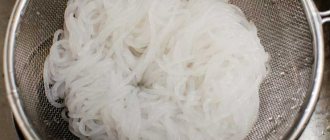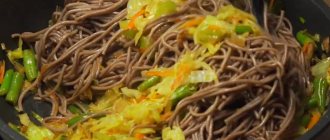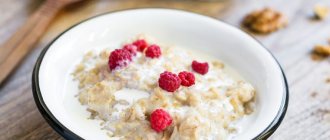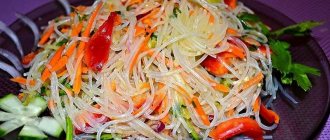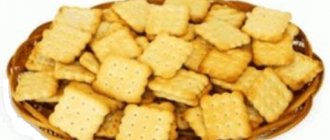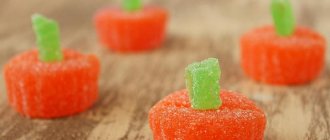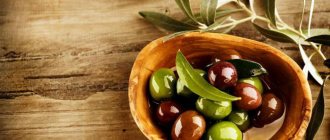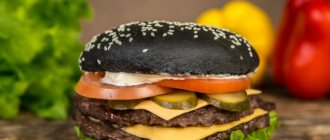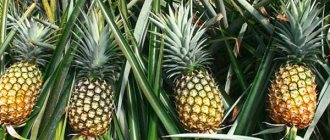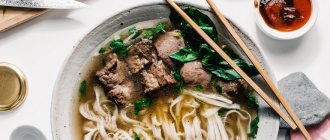Benefit
Boxed noodles have many beneficial properties, so they are often ordered in various establishments or prepared independently. For example, this product is enriched with B vitamins, as well as amino acids. Local residents of Japan, as a rule, consume such noodles due to their minimal calorie content, since they are based on light Saifun and Harusame beans.
The benefits of rice noodles have long been proven by doctors. It does not harm the body and has no contraindications, so it can be consumed by absolutely everyone.
As for the egg dish, it has long been a favorite in the European culinary tradition. Experienced chefs turn to it quite often, because it is one of the main ingredients of many delicious and aromatic dishes.
Beneficial features
Buckwheat noodles are beneficial for weight loss because the fiber in its composition promotes long-term satiety. Soba also contains high levels of thiamine, a B vitamin that helps in improving energy metabolism. In addition, the product has a number of health benefits.
Natural prebiotic
Essentially, prebiotic compounds become sources of nutrients or “fuel” for the beneficial bacteria (probiotics) that live in the gut. Prebiotics, along with probiotics, contribute to overall health, which is why almost everyone is encouraged to include them more often in their diet.
It has been shown that higher intake of prebiotic foods can increase the number of probiotic microorganisms, including Lactobacillus rhamnosus GG, L. reuteri, bifidobacteria and some strains of L. casei or L. acidophilus-group.
Prevents varicose veins
Varicose veins occur when pressure is placed on the blood vessels, causing blood to pool and the veins to swell. This condition often affects the legs because they are furthest from the heart and gravity makes it difficult for blood to flow upward.
Buckwheat noodles are rich in rutin, which is a bioflavonoid that can support the walls of veins and help them work better. Thanks to this, the dog is able to prevent the development of varicose veins and slow down the development of the disease that has already begun.
Macrobiotic food
Soya is on the list of recommended macrobiotic foods. The macrobiotic diet is a plant-based nutrition system based on the yin-yang theory originating from Asia.
According to her, the balance of yin and yang is achieved through a low-fat vegetarian diet with the right balance of macronutrients (protein, carbohydrates and fats), eating foods with a variety of energy qualities and a wide range of vitamins and minerals. This approach to eating is believed to support healthy digestion and even mental well-being.
Protein source
In most cases, it is difficult to get a significant dose of protein from noodles, but soba is unique in its high content of this macronutrient. They are literally considered the building blocks of the body, so it is important to get enough of them in your diet every day.
Buckwheat noodles are an excellent source of non-animal protein for everyone, especially vegetarians and vegans. Protein foods help increase energy production, maintain and build new muscle mass, and promote longevity.
Reducing the risk of heart disease and stroke
Studies have found that buckwheat reduces both total cholesterol and LDL (“bad”) cholesterol. Consumption of this product also helps increase HDL (“good” cholesterol) levels.
Such indicators can reduce the risk of both heart disease and stroke.
Gluten Free
People who are allergic or intolerant to gluten should not eat regular pasta. Luckily, buckwheat noodles are a great, nutrient-dense, wheat-free option for anyone who needs to avoid gluten. However, it is important to ensure that the soba you choose contains 100% buckwheat flour and has no wheat additives.
Stabilizes blood sugar levels
Although soba contains a significant amount of carbohydrates per serving, the high percentage of fiber and protein helps slow their digestion. This helps maintain normal blood sugar levels.
Harm
Separately, it is worth considering “Rollton” - instant noodles, the cost of which is no more than 30 rubles per pack. It is not considered a natural product, since it contains too many dyes and harmful additives. That is why it is not worth putting “Rollton” on a par with the magnificent dishes of Asia.
In addition to the above, it is worth noting that nutritionists have long drawn the attention of consumers to the high calorie content of any type of noodles, including instant products. Because of this, people risk almost instantly gaining excess weight, which will not be so easy to get rid of.
How to cook noodles correctly with health benefits?
- Preferably choose whole-grain, gluten-free pasta, such as whole-grain rice or buckwheat noodles.
- Eat legume noodles (lentils, chickpeas, pea noodles).
- Eat noodles in small portions and preferably have a salad or soup before the noodle dish.
- Avoid serving noodles with high-fat sauces. Use sauces with plenty of vegetables and high-protein side dishes, such as tofu or legume meatballs.
- If you like a high-calorie sauce, then at least avoid the cheese that is often sprinkled on the dish.
- If you like to eat noodles with butter, limit yourself to the minimum amount of oil.
- Always cook your noodles al dente (so they are ready to eat, but still firm enough to prevent them from becoming mushy)!
So, the unsurprising conclusion is that high quality noodles can be part of a healthy diet if they are prepared properly, not eaten too much and served with plenty of vegetables.
Based on: Scott Harris. “Is pasta good or bad for you?” 24. Juli 2021, Medical News Today Iolanda Cioffi, Lidia Santarpia, et al. “Whole-grain pasta reduces appetite and meal-induced thermogenesis acutely: A pilot study”
| ← Mustard: the magical benefits of seasoning | Chocolate: good or bad? → |
Rice
One of the most revered dishes of Asians is common in Japan and China. It belongs to the category of hearty dishes, but lacking a strong taste. When finished, rice noodles are quite elastic and pleasant to the touch. There are only 364 kcal per 100 grams of product.
The composition contains about 75% starch, which provides sufficient nutritional value. It also includes a full set of B vitamins, which are of great benefit to the human body. At the same time, it is worth noting minerals in the form of zinc, selenium, potassium, iron, phosphorus and other elements, due to the absence of which the general state of health worsens.
It is quite difficult to find the harmful properties of noodles, but its benefits are immediately noticeable. First of all, it is worth mentioning the large number of complex carbohydrates contained in the composition. They are designed to enrich muscle tissue, giving them energy for a long time. It follows from this that the product is an excellent nutritional option for those who are watching their figure. In addition, due to its minimal salt content, it can be safely consumed by people suffering from kidney diseases.
Types of noodles
This product consists of long narrow strips of dough, which is made from rice or wheat flour and kneaded in water. Egg noodles have a different composition, which includes eggs or egg powder. Each type of product has its own characteristics. Let's try to figure out how noodles differ from regular pasta and which type is the healthiest.
Egg
Asian noodles are not similar to other pasta products even in appearance. Its miniature size immediately catches your eye: these are flat strips 1 mm wide. The recipe includes the simplest ingredients - water, eggs or egg powder, salt. Flour (usually wheat) is also added to balance the taste and increase nutritional value. If yolks are used for production, the color of the product becomes rich yellow, if only the whites - grayish or translucent.
Egg noodles are considered the tastiest and healthiest when they are prepared without the use of liquid. Its nutritional value is as follows (per 100 g of dry product):
- calorie content – 304 Kcal;
- proteins – 14.16 g;
- fats – 4.44 g;
- carbohydrates – 67.97 g;
- cholesterol – 84 mg;
- ash – 1.12 g;
- water – 9.01 g.
The product is rich in vitamins D, A, group B and nicotinic acid, and it also has a good nutrient composition: potassium, magnesium, phosphorus, iron, zinc.
Natural egg noodles fit perfectly into the concept of a healthy diet. It is not for nothing that it is highly valued in the cuisines of different countries, because in moderation it really benefits the body:
- normalizes the functioning of the gastrointestinal tract;
- regulates blood sugar and cholesterol levels;
- saturates the body with vitamins, micro- and macroelements, as well as easily digestible proteins;
- provides a feeling of fullness for several hours, charging you with energy and strength for work.
If premium flour, starch, thickeners, preservatives, and flavor enhancers were used for cooking, this is already gastronomic garbage - perhaps tasty, but such a product cannot be called healthy. To be sure of the benefits and quality of noodles, you can prepare them at home. Spices will help add additional flavor notes and will also replace table salt. The dish goes well with vegetables, fish and meat side dishes. Such food will provide high-quality satiety until the next meal.
Wheat
This is one of the most popular types of pasta. Everyone knows the taste of wheat noodles, and the production technology and recipe do not require high costs. The undisputed leader in product consumption is Japan. In this country, people have eaten wheat noodles every day for centuries. It is included in most traditional Asian dishes in combination with various sauces and additives.
There are 2 main varieties of the product - ramen and udon, which was originally prepared by the Chinese, but later it moved into Japanese cuisine. A distinctive feature of the product is the absence of eggs in its composition. Udon is also considered the thickest noodle, its diameter ranges from 2 to 4 mm. The consistency is soft and elastic, the shade is white or grayish.
Energy value and composition:
- calorie content – 337 Kcal;
- proteins – 10.4 g;
- fats – 1.1 g;
- carbohydrates – 69.7 g;
- fiber – 3.2 g;
- cholesterol – 143 mg;
- ash – 3 g;
- saturated fatty acids – 0.9 g;
- starch – 59.8 g.
The product contains a high content of vitamins A, E, PP, beta-carotene, and also minerals - potassium, calcium, sodium, phosphorus.
Udon is traditionally served as a soup, pouring meat, vegetable or fish broth, adding green onions, soy sauce, and shrimp. The dish is eaten cold. This food is ideal for hot weather. It helps to cool down and at the same time satisfies hunger perfectly.
Ramen differs from udon in color, composition and method of serving. When kneading the dough, eggs are added to it, and they are also added to the finished soup. Ramen is served hot with various spices and additional ingredients - vegetables, seafood.
The benefit of wheat noodles is their high fiber content. This plant component is not absorbed by the body, but supports its basic functions. Wheat contains soluble fiber, which turns into a liquid gel in the stomach. It gently envelops the internal organs and gives them additional protection. Fiber has other beneficial properties:
- maintaining optimal blood sugar and cholesterol levels;
- normalization of intestinal function;
- providing a long-lasting feeling of satiety;
- improvement of skin condition;
- normalization of internal microflora (this has a positive effect on performance and appearance);
- prevention of breast and intestinal cancer;
- easier to wake up in the morning.
You can increase the benefits of the product by adding additional components:
- Easily digestible carbohydrates - vegetables, fruits.
- Proteins – lean meat and fish, legumes.
- Healthy fats - vegetable oils, avocados, nuts.
Regular consumption of wheat noodles has a positive effect on the functioning of the nervous system. The grain is rich in B vitamins, which are natural antidepressants: they eliminate anxiety and normalize the psycho-emotional state. Therefore, it is useful to eat the dish after work to relax and relieve stress.
Interesting fact: the creator of Zen Macrobiotics, J. Ozawa, divides all foods into Yin and Yang. Depending on the polarity, one food improves health, while the other provokes serious disruptions in the functioning of the body and various diseases. In the author’s classification, wheat noodles belong to the Yang category - they are maximally useful and can minimize the harm from Yin products.
Rice
Video: Rice noodles. Asian cuisine
Rice noodles are a classic Asian product made from rice flour. This is a favorite dish of the Japanese and Chinese, consisting of long strips of white dough with a grayish tint. Their thickness varies from 2 mm to 3 cm, and their length can reach 50 cm. Rice noodles have a mild taste, a subtle aroma with notes of beans and nuts, and they are also very filling. Many consider funchose to be its variety, but this type of pasta is made from beans. When cooked, the funchose remains transparent, and the rice noodles turn white.
Interestingly, in Asia they try to make homemade rice noodles as long as possible. According to an Eastern proverb, its length symbolizes life expectancy.
Calorie content of 100 g of rice noodles – 364 Kcal. It consists of 75% starch, so its nutritional value is high. The remaining 25% is:
- vitamins PP and group B;
- minerals: calcium, potassium, iron, selenium, zinc, phosphorus;
- saturated fatty acids;
- amino acids, including tryptophan, arginine, valine, tyrosine;
- some fiber.
No harmful properties have been identified in rice noodles, but there are benefits from its consumption. The large amount of starch in its composition ensures quick saturation, since this ingredient envelops the stomach. It does not provoke weight gain.
Since the product does not contain salt, it is suitable for a diet menu for diseases of the kidneys, heart and blood vessels. The high content of minerals has a positive effect on the functions of the entire body and the condition of internal organs.
Unlike wheat noodles, rice noodles contain virtually no fiber, making them easier to digest by the body. Therefore, the dish is recommended for children and the elderly.
Other beneficial properties of rice noodles:
- strengthening the nervous system;
- improving memory and attention;
- cleansing blood vessels;
- activation of metabolic processes;
- providing the body with energy;
- improvement of cellular regeneration and brain function;
- slowing down the aging process.
Wheat
This type of noodle is considered the most common of pasta products. It is made from water and wheat flour. The calories in noodles are a pleasant surprise for those losing weight. Per 100 grams of product - 337 kcal.
This variety appeared around 5000 BC, but is still very popular today. Royals highly valued the product and often enjoyed its taste. Initially, it could only be purchased by noble segments of the population, but literally in the last century it became available to everyone.
Ramen
Among the well-known types of noodles, it is necessary to include the product whose appearance is familiar to all people. It flaunts on store shelves as an instant product. Included with it, the buyer receives seasoning and oil of dubious origin. By pouring all these components with hot water, the consumer receives an almost complete pasta product, called in our area “instant noodles.” Its calorie content is 340 kcal.
Ramen is typically served with meat broth, bamboo shoots, green onions, eggs and ginger root. All these ingredients perfectly complement it, making the taste brighter and more memorable.
Funchoza
Soy noodles, a type of Asian cuisine, are sold dry. It is a favorite among gourmets. It is often called glass, because in appearance it really resembles glass. After cooking, the funchose threads acquire a transparent texture. Calorie content per 100 g is only 320 kcal.
The composition of the noodles is considered rich. There is starch from legumes, which include mung, yam, canna and potato. Today, corn starch is increasingly used for its preparation.
The benefits of funchose are undeniable. It lies in the vitamin and mineral composition. The product contains vitamins B, PP and, of course, E. In addition, there are minerals: potassium, phosphorus, magnesium, selenium, iron. As a rule, noodles are not salted when cooked, so people with kidney problems are allowed to consume them in any quantity.
Is it possible to eat pasta while losing weight?
In addition, the amino acid tryptophan contained in spaghetti helps you sleep and get rid of some forms of depression. What happens is this:
Once in the brain, it turns into serotonin - the so-called happiness hormone, which lifts your mood, regulates appetite and increases life expectancy. It is known that complex carbohydrates, which pasta is exceptionally rich in, help lower blood cholesterol levels, which means that pasta lovers are not at risk of many cardiovascular diseases, atherosclerosis and senile memory loss.
Spaghetti made from wholemeal flour contains a large amount of fiber, which means it is useful for those who have intestinal problems. As for those extra pounds, they gain weight mainly not from the pasta itself, but from the fatty sauces that are generously flavored with spaghetti.
In addition, Italian nutritionists have developed a special pasta diet for those who want to lose weight. Afternoon snack: green vegetable salad dressed with olive oil, stewed cauliflower, apple.
Regardless of the form, all pasta is prepared from soft and durum wheat. And if the former are more reminiscent of bread in taste and nutritional value, then the latter are considered classic. The main advantage of pasta made from durum wheat is that it almost never gets overcooked and does not require being doused with cold water after cooking.
They have more healthy fiber and fewer calories. The fact is that for the production of classic pasta, only durum wheat and water are used. Therefore, before you put pasta in the grocery cart at the store, you should carefully study the label and pay attention to the contents of the pack. It just seems so easy to cook pasta.
And there are secrets here. In order to cook spaghetti correctly, you need to stock up on a large saucepan and enough water so that the pasta does not stick together during the cooking process. The optimal ratio is: per g of pasta - 1 liter of water and 10 g of salt.
The pasta is poured into boiling water, thin and short, slowly so that it does not stick to the bottom of the pan. Long pasta is not broken, but fanned out. When the spaghetti is slightly softened, you can drown the part of the pasta sticking out of the water. Some people add a little vegetable oil to the water to prevent the pasta from sticking.
Recipes for dishes with buckwheat noodles
But is it necessary? The oil can clog the pores of the noodles, causing the sauce to slide off the surface of the noodles and not be able to soak them in. To prevent the pasta from sticking, stir it often. There is no need to pour cold water over freshly cooked spaghetti. The water will wash away the layer of starch from the pasta, making it more difficult for it to combine with the sauce. As for the dressing, a simple rule applies: the thinner and more delicate the pasta, the lighter and thinner the sauce served with it should be.
How is funchose beneficial for health? Is it possible to eat funchose while losing weight? Calorie content of funchose Benefits of funchose for weight loss Harm of funchose on a diet How to cook funchose? Kostroma Who's first? Very different noodles Subtleties of cooking. Buy instant noodles in Moscow, price for instant noodles in the Utkonos online hypermarket. Instant noodles: harm and benefit: doshirak and rollton.
All have their advantages and disadvantages. Not everyone is suitable for losing weight.
Instant noodles for weight loss are popular among supporters of mono-diets. Fans of the product claim that with its help you can get rid of several extra pounds in a week, without making additional efforts and without feeling hungry. To understand how right they are, it is necessary to study the beneficial and harmful properties of this type of pasta. Noodles intended for instant cooking are sold in Russia under the Rollton and Doshirak brands.
A person in a store may encounter the following species. These noodles come from Japanese cooking. Buckwheat noodles are useful for weight loss because they contain no fat, but they contain a lot of fiber, slow carbohydrates, and proteins. In addition, it contains enough iron and B vitamins.
A diet based on a healthy product made from durum wheat answers the question of whether it is possible to eat pasta while losing weight. It is unequivocal: it is possible. The product not only contains a lot of useful components, but also gives the body a feeling of fullness for a long time. It is important to know what ingredients you can combine paste with when losing weight. Articles on the topic What not to eat when losing weight - list of products Funchoza for weight loss - composition and benefits, glycemic index and calorie content List of foods not to eat when losing weight.
And this is important when losing weight, when there is no time to make complicated recipes. This species also came from Asia.
The benefits and harms of instant noodles: is it worth eating at all?
It has an average calorie content, contains complex carbohydrates and many vitamins. Noodles make you feel full for a long time. Although you shouldn't overeat it. G products contain more calories, mostly carbohydrates, some protein, and no fat.
Soba
Japanese noodles are closely related to the must-have dishes of Southeast Asia. It is very popular in China and Japan. The dish is usually served cold. This is explained by the climatic conditions of the regions, because the summer period there is always very hot and with high humidity. At the same time, per 100 g of dish there are only 350 kcal.
The benefits of Japanese noodles have been proven many times by scientists. Here, the first thing we need to mention is the fact that buckwheat itself has many beneficial properties, thanks to which it has a positive effect on the consumer’s body.
Soba is made from buckwheat and has a mild taste. As a rule, it is made as a separate dish, soups are cooked with it and served as a cold appetizer. At the same time, you can cook it in both regular and salted water, since this has almost no effect on the taste. The most important thing is to rinse the noodles with cool, clean water to remove any remaining starch.
Green tea is often used in the preparation process. It allows you to achieve a more refined taste and significantly increases the benefits. The result is a dish that can be classified as an unusual delicacy.
For lovers of mono-diets, or is it possible to lose weight on doshirak?
If you are a crazy experimenter and a lover of various mono-diets, you will probably be wondering whether it is possible to eat rollton while losing weight without adding anything else. Let's look at this from a mathematical point of view.
To lose weight you need a calorie deficit. Consuming 1200 kcal per day with little physical activity will do what you need. If you eat four servings of doshirak daily, you will receive per day: 1120 kcal, 22.4 g of protein, 48 g of fat, 152 g of carbohydrates.
Add one orange for 70 kcal and the calorie limit has been reached. Not too bad if it lasts a few days. If you burn about 300 kcal more, and you will burn them if you just walk and do household chores, then you will lose weight. The Rollton diet is a completely feasible idea.
The only bad thing about this is that subcutaneous fat will remain on your body due to the carbohydrates in the doshirak. You want toned muscles, not loose fat. Therefore, it will not be possible to change body composition and change the percentage of fat and muscle using a diet on a pre-shirak diet. In this sense, only protein works without competition.
Protein has been shown to increase feelings of fullness and reduce hunger, making it a useful tool for weight management.
So, noodles being low in fiber and protein does not make them the best option for effective and proper weight loss.
With only 5.6 grams of protein and 1 gram of fiber per serving, this meal likely won't do much for your hunger levels or satiety. So while it's low in calories, it may not make a difference to your waistline. But it will affect a sad mood, since the feeling of hunger will be present.
The calorie content of cooked pasta is 160 kcal in every 100 g, provided that it is made from durum (durum wheat). When cooked for up to 5 minutes, the glycemic index will not exceed 40-50. Due to this low rate, pasta is slowly digested and broken down in the stomach, and glucose gradually enters the blood. Because of this, the feeling of fullness lasts quite a long time; after a portion of the right noodles, you won’t want to eat for a long time.
A standard serving of noodles is 140 g. With this amount of food, a person will receive 220 kcal of energy.
Those who do not follow the basic rules get fat from pasta:
- eat only products from solid varieties (durum);
- eat pasta without anything or with low-calorie foods (vegetables, sauces);
- increase the amount of fresh vegetables and fruits in the diet;
- replenish the body's need for protein with low-fat foods (poultry, seafood);
- eliminate harmful fats, leave vegetable oils, preferably olive oil - it is rich in unsaturated fatty acids;
- abstain from flour and sweets;
- do not abuse salt;
- drink a liter of water per day, green tea is allowed.
You can replace pasta with potatoes when losing weight. If you do not combine it with fatty meat, but eat it “without anything,” then there will be no harm to your weight.
Shirataki
The traditional type of noodles for Japanese residents is gaining popularity among other nationalities every year. This option is distinguished by its appearance, since the strips are very thin and transparent, and also by its negligible nutritional value. Calorie content per 100 grams is equal to 9 kcal.
The noodles contain amorphophallus konjac. It goes on sale both dry and soaked. In the second option, there is very little water and a food additive such as glucomannan, which is soluble fiber classified as dietary.
The benefits, of course, depend on the composition. Fiber plays a special role here, as it has an absorbent effect and lowers cholesterol levels. In addition, noodles, unlike an instant product, allow you to regulate stool and significantly improve digestion.
Shirataki is even included in the list of allowed foods on the Dukan Diet. There it is allowed to be consumed in unlimited quantities.
Whole grain
Pasta takes up a fairly large part of every person’s diet. Whole grain noodles are consumed by almost all people and are used to prepare various dishes. It is produced, as a rule, from premium durum wheat. There are about 305 kcal per 100 g of product.
The noodles contain rye and wheat flour. Thanks to it, the main ingredient retains all its constituent elements, and, consequently, biologically active substances with vitamins. This increases the number of beneficial properties for the human body.
The benefit of the product lies in the content of the necessary elements. Vitamins B, E, A, H, as well as PP are present here. In addition, the composition contains iron, potassium, magnesium, molybdenum, plant estrogens and dietary fiber. Other pasta products cannot contain as many properties, so whole grain noodles are always held in high esteem.
What are noodles made of?
Noodles are traditionally made from grains - wheat (soft or durum), spelled or rice. Meanwhile, there are so many varieties of noodles. So, there are noodles made from buckwheat, quinoa, millet, kamut, emmer, corn and einkorn. There are whole wheat noodles, white flour noodles, and pasta made with a mixture of whole wheat and white flour.
There are noodles made from legumes, such as chickpea noodles, mung bean starch noodles, soy and pea noodles, chestnut noodles and, of course, non-calorie Shirataki noodles.
Some of the above-mentioned noodles do not contain gluten, but pasta made from traditional varieties of wheat or spelled does not (contain gluten).
There are egg noodles that contain eggs. There are also pasta with turmeric, noodles with porcini mushrooms, pasta with spirulina, seaweed, nettle, garlic, spinach, etc. These noodles contain in their dry form the mentioned ingredients, which are added in powder form to the pasta dough before drying .
Cooking secrets
Tasty and high-quality noodles in boxes come out for a reason. To do this, manufacturers use some secrets that always help to achieve good results and truly surprise consumers. Once you know them, you can prepare a truly delicious dish, free of flaws. The main secrets include the following points:
- Cooking time. It is recommended to cook any noodles for 8 minutes. If you increase this time, it will turn into mush. As for Italian noodles, it is better to boil them for no more than 5 minutes.
- Flavored product. You can add herbs, mushroom powder and other spices to the dish, changing its taste, as well as adding a light aroma. But at the same time, you need to be careful that the smell of the noodles matches the products that are used as a complement to it.
- Dough proofing. After mixing the ingredients, the finished mixture will need to sit for at least half an hour.
- Slicing. When the dough dries, it can be easily cut with a knife.
- Type of flour. It is best to prepare noodles from premium flour, as this is what will ensure good shape.
- Storage. If there is a need to keep the noodles in a remote place, they must first be thoroughly dried and distributed into cardboard boxes.
Recipe for egg noodles with green vegetables
The noodles are boiled in the usual way. Pour water into a container with a volume 4 times greater than the amount of dry product, bring it to a boil and lower the bunch according to the spaghetti principle. During cooking, you can add a little salt, soy sauce or Japanese vinegar. You can do without spices at this stage, and add seasonings during further preparation. The finished boiled soba is placed in a colander, allowed to drain a little and dry.
There is one easy way that will help you measure the amount of noodles per serving without any extra effort. To do this, take a bunch of pasta and see how much fits into the neck of a half-liter plastic bottle. This indicator is, of course, conditional. For those who adhere to a diet, the serving size can be taken a little less. But on average, you can focus on this method.
With vegetables and chicken
To prepare the dish you will need:
- Bell pepper;
- Bulb;
- Several stalks of green asparagus;
- Pickled ginger;
- 400 g chicken fillet;
- Buckwheat noodles.
Boil the noodles and leave to drain. At this time, cut the vegetables into small pieces and fry them in a frying pan with the addition of soy sauce. At the end, add chicken pieces and cook until done. Without removing from the heat, place the noodles in the pan, stir and simmer for another 1-2 minutes.
This delicious, savory soup will add variety to your daily diet. Seafood lovers will definitely appreciate the dish. To prepare it you will need:
- 100 g mussels;
- 100 g shrimp;
- A small portion of smoked eel;
- 4 sheets of seaweed;
- Buckwheat noodles;
- A little pickled ginger.
Add a portion of noodles to boiling water and cook over medium heat for 3 minutes. Add mussels and shrimp to the broth. After a few minutes, remove from heat, add pre-crushed seaweed and eel, season with ginger and mix well. Serve hot.
With shrimps
The combination of soba and seafood is considered one of the most successful. To prepare a delicious dish, boil 4 servings of noodles and 400 g of shrimp separately. If we are talking about preparing dinner for a large number of guests, the amount of food can be increased proportionally. Heat a frying pan, pour in some soy sauce and place the cooked shrimp and noodles on it. Add some soy asparagus and cook until most of the liquid has evaporated. After this, the dish can be served.
Asparagus Casserole
For the casserole - 400 g of asparagus, 400 g of boiled rice noodles, 200 g of pollock fillet, optional carrots or bell pepper, and ground black peppercorns, 40 g of hard cheese and a tablespoon of soy sauce. Additionally - a baking dish.
Rice noodles are boiled separately. Rice noodles are placed on the bottom of the baking dish, followed by pollock fillet, vegetables, each layer is “laid” with a small portion of a mixture of cheese and soy sauce. The dish is baked at 180 degrees for 30-40 minutes and served hot.
Rice noodle salad
200 g each of shrimp and squid, 300 g of boiled rice noodles, any green leaf lettuce, such as romaine, or even kale, a tablespoon of sour cream, a teaspoon of creamy mustard or mustard powder, fresh cucumber.
Boil shrimp, squid and noodles and cool in a colander. Mix sour cream with mustard powder or mustard, chop fresh cucumber, chop or disassemble the salad by hand, mix all the ingredients of the dish in a deep salad bowl, and leave in the refrigerator for 20-30 minutes before serving.
Rice noodles with oriental beef
8 prunes, 1 carrot, red onion, a glass of vegetable broth, red pepper, ginger, cinnamon, sesame oil, sea salt, 300-400 g of glass or boiled rice noodles, 400 g of cauliflower, and 200 g of beef.
Chop all the vegetables and prunes, quickly fry in sesame oil along with spices, mix in a deep frying pan, and add beef. Add vegetable broth, reduce heat, close the lid and simmer over low heat until the meat is cooked. Add rice noodles, stir.
Rice noodle soup with squid
150 g raw peeled squid, rice noodles, 1 standard portion or 30-40 g dry, seaweed, white onion, carrots, miso soup base, sweet potato tuber.
Dissolve the base for miso soup in water, add shredded squid, sweet potato tuber, and cook until tender. Crush the seaweed and add it to the finished dish.
Spicy rice noodles with bean paste
For bean paste - a can of canned red beans, a white onion, black pepper on the tip of a knife, 1 cm of ginger root, and red pepper if desired, olive or sesame oil. For the main course, 4 servings of rice noodles, soy or teriyaki sauce, or sea salt.
Heat the oil over low heat in a deep frying pan, add spices and continue heating, add beans. Then grind the beans with spices into a paste in a blender. Cool. Boil the rice noodles, drain in a colander, then add soy sauce or salt to taste.
So, rice noodles are an excellent choice for those looking for an inexpensive and tasty side dish, they allow for experimentation in the kitchen and can be combined with many types of foods.
The appearance of Asian noodles is slightly different from other pasta products. The first thing that catches your eye is its miniature size - flattened, flat strips, the width of which is 1 millimeter. It may seem that such jewelry work requires a special dough, but the basis for the noodles are the simplest ingredients possible - water, eggs or egg powder, salt and flour (wheat is most often used for a balanced taste and high nutritional value).
To prepare the product, you can use either whole eggs or the white or yolk separately. The color of the finished product directly depends on the eggs. Noodles made from yolks will be a rich yellow color, while noodles made from whites will look grayish or half-transparent.
Regardless of the color and content of yolks/whites, the liquid in which the Asian delicacy is cooked always remains crystal clear.
There are whole special schemes for preparing egg noodles. Some of them exclude the use of liquid - only eggs, flour and spices are used for shaping. Such noodles are especially valuable in terms of taste and energy value.
It all depends on the degree of processing of the product and its components. If the flour was made only from high-quality flour (coarse/durum wheat), eggs and filtered water, then the noodles are perfect as a healthy side dish. If premium flour, thickeners, starch, various preservatives and flavor enhancers were used in the preparation, then the product becomes gastronomic garbage.
To be absolutely sure of the quality and benefits of the dish, prepare it yourself. This way you can control all the cooking processes and create unique noodles with a touch of personality. There is no need to experiment with flour or egg powder. Spices are a real field for gastronomic searches. Eliminate regular table salt from the recipe and add the abundance of spices that seems most beneficial to you.
Don’t forget to properly combine noodles with vegetables and meat/fish side dishes to properly saturate your body until your next meal.
We will need:
- egg noodles – 80 g;
- garlic – 2 cloves;
- chili pepper – 2 pcs;
- zucchini – 2 pcs;
- asparagus (pre-blanched in boiling water) – 2 pcs;
- fresh green peas – 50 g;
- fresh spinach – 100 g;
- olive oil – 1 teaspoon;
- coconut milk – 100 ml;
- salt/pepper/favorite spices to taste.
Preparation
Cook pasta until al dente (cook 1 minute less than cooking instructions). Heat a frying pan, add olive oil, fry the garlic and chili pepper. Once the vegetables are soft and golden brown, add the chopped zucchini, green peas and asparagus (previously blanched) into the pan. Fry the vegetable mixture until cooked. There is no need to use spices at this stage - they will be needed in the final part of cooking.
Once the vegetables are ready, pour the coconut milk into the pan and bring the mixture to a boil. Add egg noodles to boiling coconut-vegetable broth. Reduce heat and heat the dish until the noodles are completely cooked. Add your favorite spices, taste the dish periodically and adjust the flavor palette.
Home option
The legendary homemade egg noodles are made from simple ingredients and do not require any special skills. For this you will need to take:
- 300g flour;
- a couple of eggs;
- 5 g salt;
- 1/2 glass of water.
If desired, you can experiment with homemade egg noodles by changing the taste. To do this, you can take not only wheat, but also rye, buckwheat or rice flour. By combining several types, the end result is sure to produce a memorable taste.
The process of making noodles is very simple:
- Sift the flour into a mound and then make a well in it.
- Beat the eggs into the center and add salt.
- Gradually add water and knead the dough.
- Mix the mixture with a spoon, then knead with your hands.
- Roll out the resulting dough into a thin sheet.
- Cut the layer into strips and leave for 20-25 minutes.
- Cook as usual (until required softness).
How to cook and serve
Cooking noodles is slightly different from the usual cooking of noodles, even if we are talking about rice or any other kind.
There are special rules and procedures that will allow the preliminary preparation to be carried out correctly. It’s not enough to just take out the pasta and throw it into the water - you definitely won’t be able to get a tasty and healthy dish. Let's figure out together how to cook shirataki, what you need to know, be able to do and how to serve the product. Opening a package of konnyaku pasta reveals that it has a strong unpleasant odor. Don't worry about this as it is not an indicator of quality. The aroma will completely disappear during the cooking process, so just ignore it.
Boiled
- Remove the top package without special precautions; most often there is another one inside.
- Most often the bags will have instructions on how and where to open them, but you can simply cut the plastic off with kitchen scissors.
- There may be some liquid inside the bag - this is normal. It will have to be drained.
- Shirataki vermicelli must be rinsed for some time under running cold water. The Japanese recommend keeping it in a colander under the tap for two to three minutes, stirring lightly with your hands or a spoon.
- Boil water, salt it if necessary, and then throw the noodles into the ready-made boiling water.
- You need to cook the noodles for two or three minutes, some recommend increasing this time to five. It is very important not to overcook the product, otherwise it may not be chewable at all. Its qualities will not suffer at all.
- Place the noodles in a colander and let all the liquid drain. No need to rinse.
Fried
- Remove the pasta from the bag and rinse in the same way as in the first cooking method.
- Place a frying pan on the fire (preferably made of cast iron), pour a little vegetable oil into it. Heat until a drop of water dropped into it sizzles loudly.
- Place the noodles in the pan and fry for one minute, turning them constantly.
- When all the liquid from the product has evaporated and the vermicelli itself becomes dry, the process is complete - it can be served.
*You don't need to cook this type of noodles for too long. This can cause it to become rubbery or oaky, making it impossible to eat.
Shirataki can be served as an addition to other dishes, or vice versa - as the main ingredient, to which various products are already added. She picks up smells and tastes well, for which she is especially appreciated by chefs. These noodles can be used in recipes that call for regular pasta, pasta or noodles made from wheat or other flour.
"Carrot" dish
An amazing and memorable dish is noodles with carrots. The main ingredients here are:
- vegetable oil - a tablespoon;
- carrots (already grated) - 200g;
- eggs - 3 pieces;
- salt;
- flour - as much as needed to thicken the dough.
The first step is to boil the carrots. When it has cooled, all ingredients, except flour, need to be mixed in a blender. Then pour flour into a homogeneous mass in a thin stream, stirring at the same time. The result should be a stiff dough. It must be divided into 4 parts, each of which is rolled out and cut into strips. They need to dry for no more than half an hour. The noodles are cooked as usual.
Udon
Lenten noodles have a rather labor-intensive preparation process, but also have a great taste. For it you will need:
- 500 g flour (unrefined);
- glass of water;
- 4 small spoons of salt;
- 150 g wheat flour.
First you need to heat the water and dissolve the salt in it. Afterwards, pour all the flour into a deep container and mix thoroughly. Then water and salt are poured in and the dough is kneaded.
The elastic and tough mass must be rolled into a ball, wrapped in a bag and covered with a towel. In this position, the dough should be beaten with a rolling pin, then taken out and rolled into a thin sheet. Immediately after this, it is folded in half and all previous steps are repeated with wrapping it in a plastic bag 3 times. When you get a perfectly smooth dough, you need to keep it for 4 hours, and then beat it for the last time and roll it out as thin as possible.
The resulting layer must be folded three times, with the sides overlapping toward the center. Next, use a sharp knife to cut the dough into rings, the thickness of which does not exceed 5 mm. Immediately after this they need to be boiled for 8 minutes.
